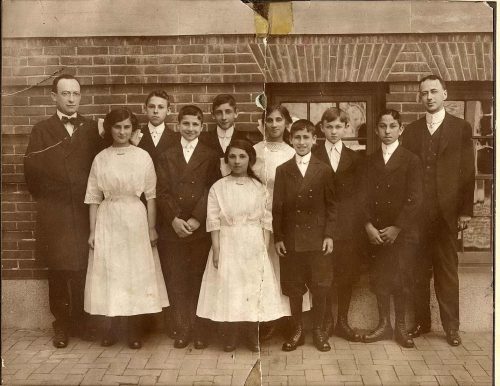Religious and Moral Education

Part III of “Poor Man’s Boarding School,” article by Anita Kassof, former Assistant Director at the Jewish Museum of Maryland. Article originally published in Generations 2009-2010: 50th Anniversary Double Issue: The Search for Social Justice.
Miss part I? Start at the beginning.

Freudenthal’s emphasis on spiritual instruction was consistent with the expressed and implied intentions of the HOA’s founders, to whom both religious and secular education were of paramount importance. As Rayner said in his dedication speech, he and his co-founders aimed to raise their wards “to become good American citizens as well as true Israelites.”[i] Freudenthal encouraged in his wards moral behavior in keeping with nineteenth-century middle class ideals of industry and restraint. Like most other orphanages of the period, the HOA taught conformity, obedience, and respect for authority as a means to build or reform character. Its administrators believed that a disciplined daily regimen of hard work and study was the underpinning of children’s future success.[ii]
Although the HOA was established before the Progressive era—generally dated from the 1890s to the 1920s—it adhered to an educational philosophy that foreshadowed progressive theories about the potential of education to reform the lives of individuals of all classes. When Rayner proclaimed in his dedication remarks that the HOA would become a “first class institution of learning,” he implied that poor children were as capable as their advantaged peers of achieving.[iii] The HOA’s founders and trustees, as well as Freudenthal, believed in the power of education and environment to empower disadvantaged children, regardless of background or heredity.
The HOA’s leaders also believed that physically removing children from negative influences—an “immoral” mother, a squalid neighborhood, “incorrigible” peers—would enable their transformation into productive adults.[iv] To this end, visits from relatives were strictly regulated, and children who left the orphanage grounds without permission were punished.
The HOA’s trustees admitted its wards selectively. While they aimed to remove worthy children from unwholesome or dangerous situations, they declined admission to children whom they suspected were beyond reform. As Freudenthal wrote in his July 1903 report to the trustees, “[T]his Institution ought not to be considered a ‘house of correction’ and children of depraved habbits [sic] should under no consideration be admitted.” Nor, presumably, would “depraved” children be permitted to stay if their flawed characters became apparent after admission. “Incorrigibles” might be hired out to learn a trade or, if possible, returned to their parents, Freudenthal suggested in December 1895. In a poignant addition to his September 1900 ledger entry, Freudenthal noted, “P.S. Nathan Legetsky reported incorrigible and returned to his father, leaving number of children 68.”[v]
Like “incorrigibles,” runaways were dismissed for repeat offenses. The HOA’s children—who left the grounds for school or for supervised group outings—had greater freedom than children in many nineteenth century orphanages whose campuses were completely closed.[vi] Michael Aaronsohn recalls that even though the HOA’s fence was topped with “sharp points of iron spikes” it did little to deter adventuresome boys. They routinely scaled the walls in order to go swimming or play ball, returning in time for the next meal, presumably calculating that the big thrill was worth a small risk.[vii] Other runaways stole away to visit relatives and tried to slip back undetected. Those who were caught—either in the process of returning or by a local policeman—posed an embarrassing dilemma for Freudenthal and the trustees. If the HOA was, indeed, a “home,” in Freudenthal’s parlance, why were its wards compelled to sneak out?
Freudenthal and the trustees feared that, like disease, the habit of running away was contagious, as transgressors tempted others to emulate them. While first- and second-time offenders might be reprimanded and urged to do better, Freudenthal and the trustees dealt harshly with chronic runaways. The superintendent recounted the case of Simon Levy, “age betw 11 & 12 years who have given us a great deal of trouble last year by starting the run-away habit of our Boys, has again transgressed against the rules and disappeared on Sabbath afternoon.” He recommended the boy’s discharge.[viii]
Each time a child ran away, the Board reviewed his case and reconsidered him for readmission. Perhaps some children, denied reentry to the orphanage, were secretly relieved. Abraham Schwab, for example, was admitted to the HOA at the age of five, while his brothers Louis and Jacob stayed home with their widowed mother on East Lombard Street. Freudenthal’s ledger notes that the boy “ran away from Public School at 1:30 P.M. March 9, 1904 was brought back to the Institution by an Officer of the Police at 8:30 P.M. Ran away the 2nd time from Public School March 18. 1904 brought back on March 19. At 5 P.M. Ran away again from Public School March 28. Ran away for the 4th time from Public School . . . October 27, 1904. Refused admission by the Board again and given to his mother.”[ix]
Continue to Part IV: Life at the Orphanage
[i] Ibid., 8-9.
[ii] David Rothman, The Discovery of the Asylum (Boston: Little, Brown, 1971), 211-212.
[iii] Rayner address; Zmora, Orphanages Reconsidered, 24.
[iv] For discussions of orphanages’ reformatory roles, see Rothman, Discovery of the Asylum, 210, and Hasci, Second Home, 55-56.
[v] HOA superintendent’s reports.
[vi] Hasci, Second Home, 55-56.
[vii] Aaronsohn, Broken Lights, 15, 18-19.
[viii] HOA superintendent’s report, March 1908.
[ix] HOA admission ledger, vol. 2, 54; HOA superintendent’s report, October 1904.
